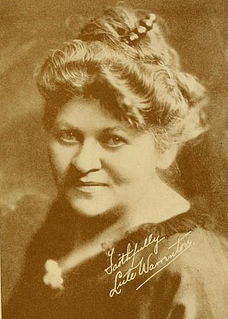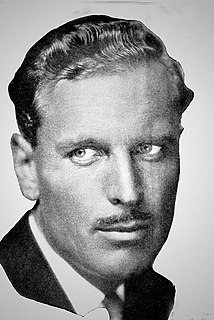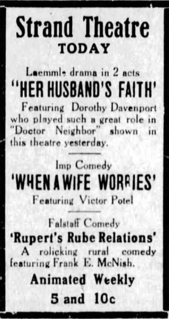
Butterfly also known as Butterfly Pictures was a film production company that produced and released films spanned as part of the Universal Film Manufacturing Company program from 1917 to 1918.

Butterfly also known as Butterfly Pictures was a film production company that produced and released films spanned as part of the Universal Film Manufacturing Company program from 1917 to 1918.
On April 28, 1917, Butterfly Pictures was announced in Motography a new brand of feature films that would be released as part of the Universal exchanges. These films would be five reels in length and would be produced at the Universal Film Manufacturing Company studios in California. [1]
| Name | Release date (Year/Month/Date) | Director | Braff Index [2] [lower-alpha 1] |
|---|---|---|---|
| Eternal Love | 1917-05-07 | Douglas Gerrard | 2180 |
| The Phantom's Secret | 1917-05-14 | Charles Swickard | 6167 |
| Like Wild Fire | 1917-05-21 | Stuart Paton | 4608 |
| Money Madness | 1917-05-25 | Henry McRae | 5360 |
| The Circus of Life | 1917-06-04 | Rupert Julian | 1350 |
| The Field of Honor | 1917-06-11 | Allen J. Holubar | 2379 |
| The Flame of Youth | 1917-06-23 | Elmer Clifton | 2533 |
| Man and Beast | 1917-06-25 | Henry McRae | 4982 |
| The Plow Woman | 1917-07-02 | Charles Swickard | 6248 |
| The Reed Case | 1917-07-09 | Allen J. Holubar | 6610 |
| High Speed | 1917-07-16 | George L. Sargent | 3566 |
| The Double Standard | 1917-07-23 | Phillips Smalley | 2005 |
| Follow the Girl | 1917-08-06 | Louis W. Chaudet | 2623 |
| The Midnight Man | 1917-08-13 | Elmer Clifton | 5221 |
| The Lair of the Wolf | 1917-08-20 | Charles Swickard | 4441 |
| Straight Shooting Alternatively: Joan of the Cattlelands | 1917-08-27 | John Ford | 7693 |
| Who Was the Other Man? | 1917-09-03 | Francis Ford | 9092 |
| The Little Pirate | 1917-09-10 | Elsie Jane Wilson | 4683 |
| The Spindle of Life | 1917-09-17 | George Cochrane | 7552 |
| The Edge of the Law | 1917-09-24 | Louis W. Chaudet | 2117 |
| The Secret Man | 1917-10-01 | John Ford | 7030 |
| The Girl Who Won Out | 1917-10-08 | Eugene Moore | 2978 |
| Forty Nine-Seventeen ('49-'17) | 1917-10-15 | Ruth Ann Baldwin | 2729 |
| Society's Driftwood | 1917-10-22 | Louis W. Chaudet | 7436 |
| A Marked Man | 1917-10-29 | John Ford | 5070 |
| John Ermine of the Yellowstone | 1917-11-05 | Francis Ford | 4248 |
| The Cricket | 1917-11-12 | Elsie Jane Wilson | 1541 |
| The Man from Montana | 1917-11-19 | George Marshall | 4989 |
| Fear Note | 1917-11-26 | Allen J. Holubar | 2357 |
| Fighting Maid | 1917-12-03 | Edward J. Le Saint | 2443 |
| The Silent Lady | 1917-12-10 | Elsie Jane Wilson | 7250 |
| Beloved Jim | 1917-12-17 | Stuart Paton | 528 |
| Bucking Broadway | 1917-12-24 | John Ford | 973 |
| The High Sign | 1917-12-31 | Elmer Clifton | 3564 |
| The Wolf and His Mate | 1918-01-07 | Edward J. Le Saint | 9257 |
| Madame Spy | 1918-01-21 | Douglas Gerrard | 4936 |
| A Kitchen Hero | 1918-04-06 | Allen Curtis | 4388 |

Universal Pictures is an American film production and distribution company owned by Comcast through the NBCUniversal Film and Entertainment division of NBCUniversal.

Touchstone Pictures was an American film distribution label of Walt Disney Studios Motion Pictures, created and owned by The Walt Disney Company. Feature films released under the Touchstone label were produced and financed by The Walt Disney Studios, and featured more mature themes targeted towards adult audiences than typical Disney releases. As such, Touchstone was merely a brand of the studio and did not exist as a distinct business operation.
NBCUniversal Entertainment Japan LLC is a Japanese music, anime, and home entertainment production and distribution enterprise headquartered in Akasaka, Minato, Tokyo. It is primarily involved in the production and distribution of anime within Japan.

Metro Pictures Corporation was a motion picture production company founded in early 1915 in Jacksonville, Florida. It was a forerunner of Metro-Goldwyn-Mayer. The company produced its films in New York, Los Angeles, and sometimes at leased facilities in Fort Lee, New Jersey. It was purchased in 1919.
Edendale is a historical name for a district in Los Angeles, California, northwest of Downtown Los Angeles, in what is known today as Echo Park, Los Feliz and Silver Lake. In the opening decades of the 20th century, in the era of silent movies, Edendale was known as the home of most major movie studios on the West Coast. Among its many claims, it was home to the Keystone Kops, and the site of many movie firsts, including Charlie Chaplin's first movie, the first feature-length comedy, and the first pie-in-the-face. The Edendale movie studios were mostly concentrated in a four-block stretch of Allesandro Street, between Berkeley Avenue and Duane Street. Allesandro Street was later renamed Glendale Boulevard.

Lule Warrenton was an American actress, director, and producer during the silent film era. She appeared in 81 films between 1913 and 1922. She was born in Flint, Michigan and died in Laguna Beach, California and was the mother of cinematographer Gilbert Warrenton.

The Trail of Hate is a 1917 American silent drama film that portrayed the military exploits and personal rivalries of two United States Army officers stationed in the American West and later in the Philippines. The production starred John Ford, who at that time was credited as "Jack Ford". Currently classified as a lost film, this two-reel short is identified by some biographers of John Ford and in many filmographies, both in print and online, to be his second release as a director. He is also credited in various sources for writing the film's screenplay or "scenario". Other Ford biographers, however, most notably American director and film historian Peter Bogdanovich, credit this production's screenplay and its direction to John's older brother Francis Ford.
Richard Smith, also known as Dick Smith, was a screenwriter, actor, and film director. Smith was born in Cleveland, Ohio, and became a comedian active in the vaudeville era. He met his wife Alice Howell in 1910 and the two performed together as Howell and Howell. After working under direction of Mack Sennett at the American Mutoscope and Biograph Company in New York City, Smith moved to Los Angeles, California. Smith and his wife starred in reels together produced by L-KO Kompany.

Who's Your Neighbor? is a 1917 silent American propaganda and drama film directed by S. Rankin Drew. The film's plot focuses around reformers who pass a law to force prostitutes, including Hattie Fenshaw, out of the red light district. Fenshaw becomes Bryant Harding's mistress and lives in an apartment next door to a reformer, and continues to ply her trade. After Fenshaw becomes familiar with Harding, his son, daughter and the daughter's fiancé, the climax of the film occurs as the cast assembles at Fenshaw's apartment. Harding returns and a fight breaks out that results in the reformers' arrival and concludes with the presumption that Fenshaw returns to a place of "legalized vice". The drama was written by Willard Mack and was his first foray into screen dramas. The film proved controversial, but is noted as a great success. The film originally debuted on June 15, 1917, but it was rejected by the National Board of Review and was later approved after a revision, but the film continued to be labeled as an immoral production. The film is presumed to be lost.

Nina, the Flower Girl is a lost American 1917 silent drama film produced by D. W. Griffith through his Fine Arts Film Company and distributed by Triangle Film Corporation. The film starred Bessie Love, an up-and-coming ingenue actress. It also marked the final acting role for Elmer Clifton, who was by then moving on to directing full-time.

Fanchon the Cricket is a 1915 American silent drama film produced by Famous Players Film Company and distributed by Paramount Pictures. It is based on a novel, La Petite Fadette by George Sand. It was directed by James Kirkwood and stars Mary Pickford, at the time working for Adolph Zukor and Daniel Frohman. A previous film version of the story was released in 1912 by IMP and directed by Herbert Brenon.
The Cheese Special is a 1913 American silent short comedy film featuring Max Asher and marking the film debut of Louise Fazenda. The scenario was written by Allen Curtis, but the identity of the director is unknown. It was the first production released by the newly formed Joker productions, as part of the Universal Film Manufacturing Company. The film is presumed to be lost and there is no published synopsis of the film. Known production details state that it was shot on a beach resort and used a miniature train. The film had a wide release and was reviewed by The Moving Picture World as a low comedy suited for the burlesque theaters.
The New York Motion Picture Company is a film production and distribution company from 1909 until 1914. It changed names to New York Picture Corporation in 1912. It released films through several different brand names, including 101 Bison, Kay-Bee, Broncho, Domino, Reliance, and Keystone Studios.
The Thanhouser Company was one of the first motion picture studios, founded in 1909 by Edwin Thanhouser. It operated until 1920. It produced over 1,000 films, but several dozen of the films were of small filler subjects, educational or documentaries. Many of these smaller subjects were listed as a quarter or half a reel in length and received very little critical review or analysis by film critics and the media.

Alfred Emory Johnson was an American actor, director, producer, and writer. He started acting in silent films as a teenager. Early in his career, Carl Laemmle choose Emory to become a Universal studio leading man. He also became part of one of the early Hollywood celebrity marriages when he wed Ella Hall.
Eternal Love is a 1917 American silent drama film produced by Butterfly Pictures and released by Universal Pictures.

Barriers of Society is a 1916 American silent drama film directed by Lloyd B. Carleton. Universal based the film on the story written by Clarke Irvine and adapted for the screen by Fred Myton. The feature film stars Dorothy Davenport, Emory Johnson, and an all-star cast of Universal contract players.
Pallas Pictures was a film studio in the U.S. headed by Frank A. Garbutt. In 1913 the film production company Bosworth Incorporated was founded to release film adaptations of Jack London's stories. Hobart Bosworth was President of the company but as Jack London wrote, "Mr. Garbutt has absolute charge of the entire business of Bosworth, Inc." The company rented studio space until September 1914 when Bosworth Inc. constructed its own studio at 211 N. Occidental Blvd., Los Angeles. When Hobart Bosworth left in 1915 Garbutt assumed full control of Bosworth Inc. Several months later the company was renamed Pallas Pictures, with Melodile Garbutt listed as president of Pallas Pictures. The Pallas logo was a capital "P" with an owl on a branch.

Her Husband's Faith is a 1916 American silent short film directed by Lloyd B. Carleton. The film is based on a story by Paul Machette. Eugene De Rue developed the screenplay. This domestic society drama's features Dorothy Davenport, T. D. Crittenden and Emory Johnson.

On the morning of June 13, 1914, a disastrous fire and a series of related explosions occurred in the main film vault of the Lubin Manufacturing Company in Philadelphia, Pennsylvania. Several possible causes for the blaze were cited at the time, one being "spontaneous combustion" of highly flammable nitrate film, which was the motion picture industry's standard medium for cameras throughout the silent era and for the first two decades of "talking pictures". Millions of feet of film were consumed in the flames, including most of the master negatives and initial prints of Lubin's pre-1914 catalog, several of the company's recently completed theatrical prints ready for release and distribution, a considerable number of films produced by other studios, inventories of raw and stock footage, hundreds of reels documenting historic events that occurred between 1897 and early 1914, as well as other films related to notable political and military figures, innovations in medical science, and professional athletic contests from that period. While this fire was not a decisive factor in Lubin's decline and bankruptcy by September 1916, costs associated with the disaster only added to the corporation's mounting debts, which led to the closure or sale of its remaining operations the following year.